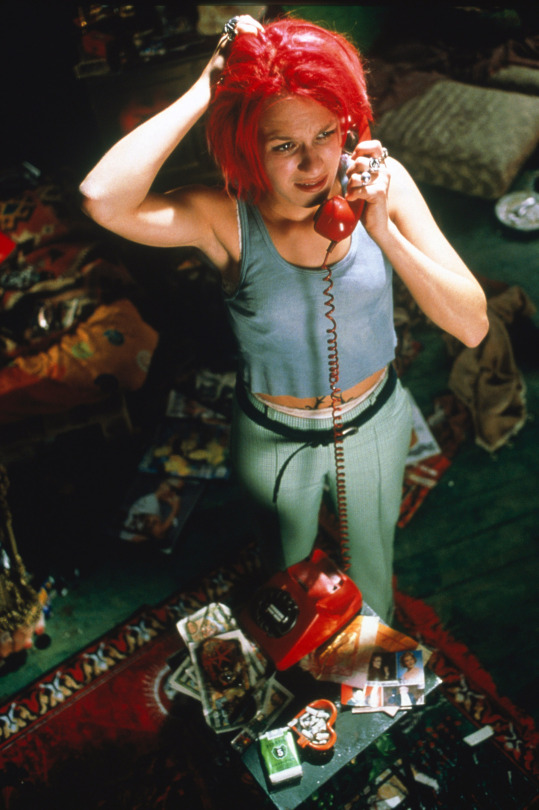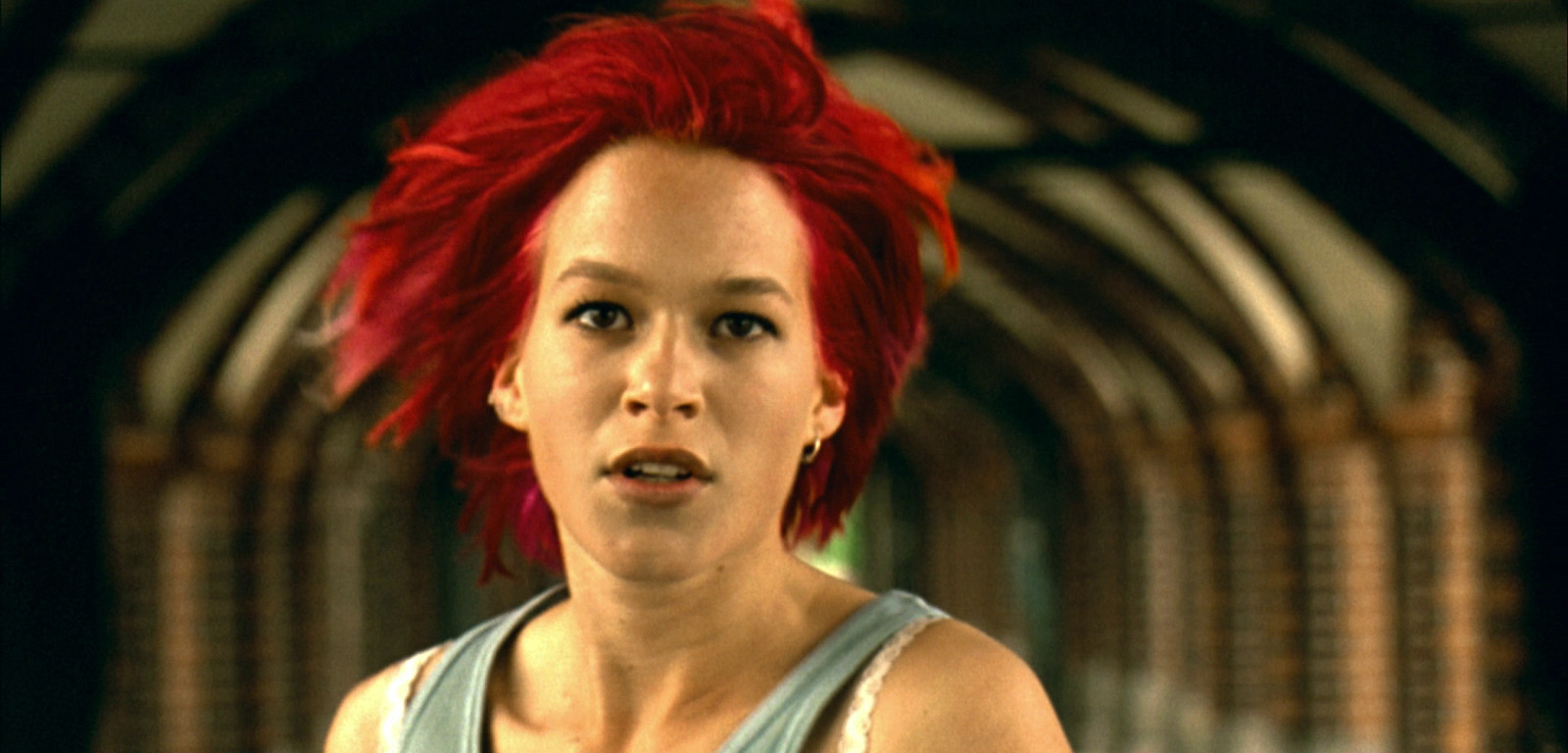When American film scholars think of German films, a few of the following pop into their minds. There is German Expressionism from the silent era for having sets that appear nightmarish or otherworldly, as these films would handle dark themes like corruption, horror, and psychology. The Nazi propaganda films that looked stunning yet had dark purposes underneath their beautiful imagery that would further influence American propaganda films (the Why We Fight series directed by Frank Capra is a prime example). And the experimental and grittiness of Germany captured in New German Cinema by filmmakers like Rainer Werner Fassbinder, Werner Herzog, and Wim Wenders. Each German cinema era has its unique, unforgettable style that has continued to influence other countries as time progressed. A particular film from the country released in 1998 that would carry on the country's innovative film techniques is the experimental thriller...
The first image takes place in a dark abyss with a cuckoo clock covered with gargoyles ticking as the pendulum swings, appearing like an opening to a horror movie. Shortly after, the camera enters inside the gargoyle's mouth, and it is daylight where the footage is now sped up as the camera rushes through a crowd of people, occasionally slowing down to give focus to some of the people. Throughout this sequence, a narrator's voice questions our place in the game of life. The last person the camera focuses on during the sequence is an authority figure breaking the fourth wall by addressing the audience with the rules of a ball game, takes out a ball, and an aerial shot shows him kicking the ball up to the sky where the crowd below form the letters for the film's title. From the beginning, the film makes itself clear that it is visually and tonally not going to be a conventional action thriller. The film is instead going to go crazy with its surreal direction expecting the audience to have fun with it, as opposed to creating a gritty, realistic action suspense film that is supposed to keep audiences fearfully on the edge of their seat.
That is not to say the film is not based on thrills either. The film's premise revolves around the title character Lola (Franka Potente), the girlfriend of the criminal bagman Manni (Moritz Bleibtreu). After losing a bag full of 100,000 Deutschmarks, he desperately calls Lola for help, informing her his boss will kill him if he does not receive the money. The only solution Manni can think of to get back the money is to rob a nearby supermarket. Lola tells Manni to wait for her, but Manni only gives her 20 minutes to produce the money before he resorts to robbery. It is up to Lola to race to the rescue of her boyfriend while figuring out how to replace the money Manni lost. A story as intense as this with a limited runtime regarding the stakes would easily fill a film's third act, making for a riveting climax. However, this is how the film's plot begins after the prologue, without any apparent warning, placing the audience in Lola's position. Except for getting visual exposition, the action immediately kicks off.
Little is described about Lola and Manni's characters to get the audience emotionally invested in their personalities. One would think as Lola runs to save her lover; the film would take a break from the action a few times to show flashbacks of Lola's past with Manni to build an emotional interest in them. But aside from the flashback in the opening scene and two flashbacks of them in bed together asking each other about their feelings, the film does not dwell long in the past for audiences to connect to the characters. The emotional intrigue for the characters and what we learn about them is focused on the present and probable future. Through each encounter, something is learned about the characters, especially Lola, whether it is a dramatic scene of Lola talking to her father, encountering a pedestrian, or her eagerness to help her boyfriend as she runs. Given the film's intense premise and bizarre direction, the audience's attachment and understanding of the characters are mainly described through actions rather than dialogue.
Just like the prologue, the film does not at all hold back from exploiting various film styles and techniques. Some scenes are shot with a 35 mm camera to make Lola's journey appear big and intense. In contrast, some scenes are shot with a video camera to create a documentary feel for certain scenes, like when a homeless man finds the bag of money as if we are watching footage from a security camera. The film is primarily shot in color, with the colors red and yellow popping out, connecting to the film's primary leads (such as Lola's hair and the various locations where Manni waits). But the film has certain scenes shot in black and white, used explicitly for the flashback sequence regarding Manni's mistake to present old grainy memories of the past, like watching an old film. The film even briefly tells its narrative in other forms of media. When Lola runs down a spiral stairwell in her apartment, avoiding a tenant's dog, the scene is depicted in hand-drawn animation. Another instance involves photographic montage. These montages usually happen for a few people Lola briefly encounters, showing their future.
The film's decision to constantly change its style may come across as obnoxiously pretentious, but it is the exact opposite. As random as the techniques are, it does not distract from the overall focus nor change the film's tone. And by the time the film reaches its second act, the experimental nature of the film starts to feel more like the film's norm. In many ways, the film's style is reminiscent of the American film Natural Born Killers (1994) by telling a crime drama with dark humor as the style keeps changing. Natural Born Killers experimental nature was to criticize how the media glorifies crime stories; in this film's case, it represents trial and error when dealing with the unpredictable in the game of life.
If Natural Born Killers is supposed to resemble a product of the problematic media the film attacks, Run Lola Run resembles a video game for its commentary on life. Lola's dyed red hair and wardrobe resembles a video game avatar like Lara Croft from Tomb Raider if she were designed as a fighter for a Japanese style fighting game. The actions of watching Lola run as she dodges one obstacle after another, stopping to gain help, and make it to her destination before time runs out plays out similar to the style and objectives in games like Super Mario Bros. or Crash Bandicoot. The soundtrack itself is an energetic electronic score sounding urgent yet excitingly playful at the same time, that would not sound out of place in games like Sonic the Hedgehog, or Tekken. Without giving too much away to further on the film's attempt to resemble a video game, for every time Lola fails, the way Lola finds another way is similar to how gamers figure out how to finish objective in a level they struggle finishing.
The film is not only a filmmaking spectacle, but is highly entertaining, well-acted, fast- paced, action-packed, has intriguing characters, and a unique way of visual storytelling. The film’s plot has a clear end goal, with characters who are easily identifiable, but leaves more than plenty of room open for interpretation and theories with small blink and miss details in every frame. It may also be one of the best video game movies in existence without serving as a film adaptation of one. Run Lola Run is not the first of its kind in German film to use a range of styles and film techniques to have a deeper meaning under a simple story, but it is regardless one of the best films of that type, making it one of the most ambitiously innovative films from the country.






No comments:
Post a Comment